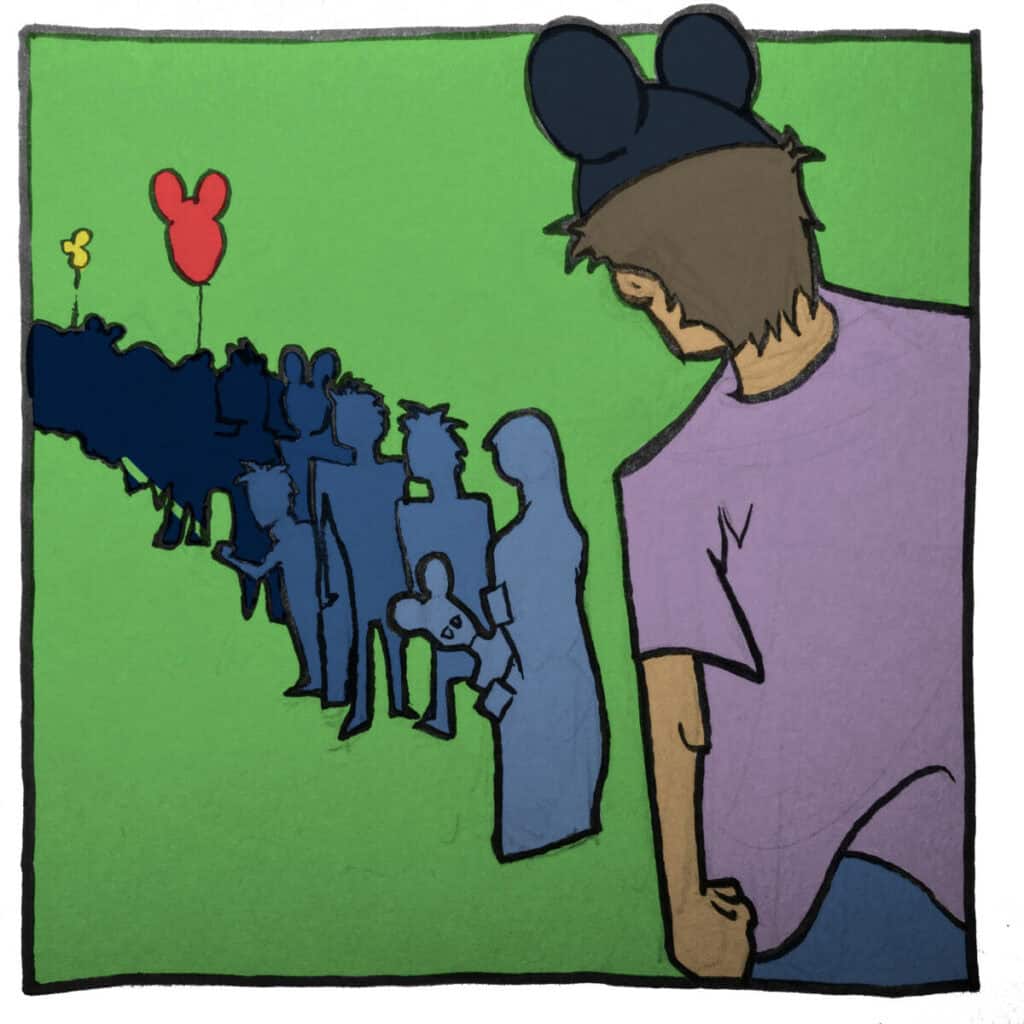
Of all the negative things people say about Disney parks, there are two that stand out. They’re expensive and there are long lines for everything. The price of a Disney park is not low, they’re probably some of the most expensive theme parks in the world. Having said that, depending on which Disney park you go to, you might find that some are more reasonable than others. There’s also the argument that a Disney park is so much better than most theme parks, that in many cases you get what you pay for. There can be a lot of debate about whether Disney parks are overpriced, but there is little debate about the fact that you will be waiting in long lines to ride any attractions and sometimes to watch a show.
Why are Disney lines so long?!?
The general assumption is that a long line happens because a ride is popular, and more people want to ride it. While new rides are always going to be busy because more people want to ride them, there are some technical reasons some other rides are busier, and it has to do with design not popularity.
Technically speaking… Breakdowns…
In the case of design there are two main reasons where poor design could lead to longer lineups. The first of these problems is breakdowns. There are some rides that breakdown a lot. Test Track at Epcot and Rise of the Resistance in Star Wars Galaxies Edge are two of the most well know rides to break down often. Both of these rides are state of the art attractions that have lots of moving parts. What makes them amazing rides is also what makes them prone to breakdown. It’s the nature of new technology, you tend to have a lot of breakdowns because the technology keeping them running is still being tested to some degree.
The thing about these two rides is not only do they breakdown a lot, but they break down severely enough that you have to shut the rides down entirely to fix them. In some cases with rides, if they break down less severely there’s a chance to set it to the B-Show. This means that they’ll keep the ride running and disguise the broken bits by either taking it out of the ride or just keeping it sedentary when it comes to animatronics. In the case of Rise of the Resistance and Test Track, when they break down they seem to break down in such a way that either the ride is unsafe, or the illusion is so broken so it’s not worth letting people ride it. I’m not an engineer, so I can’t really tell you what makes these rides break down specifically, or why they don’t just fix it (maybe they’re fixing Test Track right now).
A ride breaking down will obviously make for a long line. Even when it opens back up you end up with the people who wanted to ride it earlier crowding on with the people who want to ride it now. In some cases like Test Track and Rise of the Resistance if people hear that these rides are running they might go ride them immediately in fear that they’ll break down again and maybe even for the rest of the day so that too can create some long lineups.
Breakdowns also cause other rides in the same park to fill up as well. Since there are no guests going into these popular rides that breaks down a lot, guests have to ride something else instead. This leads to a flow effect of rides around it filling up, then if the shutdown lasts, rides slightly further away will fill, and this continues stretching throughout the park. So breakdowns are a real pain for Disney parks, and for guests. Even if you have no intention of riding Test Track, the lines at all Epcot attractions could be effected.
Ride Capacity is King
The second design flaw that makes long lineups is ride capacity. If you’re not really thinking about it, your brain just assumes that each ride at a Disney park can take the same amount of guests per hour on average. This could not be further from the truth. Some rides can manages thousands of riders an hour and some can barely handle hundreds of guests per hour. Probably the most notorious ride for a low ride capacity is Peter Pan’s flight.
While Peter Pan’s Flight is a great ride, it’s probably not deserving of one of the longest lineups in most castle parks. It’s amazing how some dark rides seem to flow so well, while the lineup at Peter Pan’s Flight goes so slowly that they had to install entertainment in the lineup to keep people busy. In fact that’s a good way to tell if a ride has a relatively low rider capacity. If you see a great deal of entertainment in the lineup, it’s probably because they know you’re going to waiting a while for this ride and it’s likely because of a low ride capacity. They also know that the line will be moving slowly enough that people will have time to stop and play with the interactive elements before the line moves forward.
On a side note, as a Disney adult I have a grudge with these interactive elements. While I’m certainly fine with kids playing with these great interactive time killers, I’d appreciate if parents didn’t treat them like a daycare for their kids. The number of times I’ve seen kids being left behind at these play areas while the parents move forward in line is insane. I say all of this for two reasons. First of all I don’t like it when there’s a block up of kids near these interactive elements that make a slow line move even slower. Second, I too want to play with these interactive elements, I am also bored, and if you leave your kids behind it makes it harder for those standing closer to those interactive elements to play with them when there’s kids that should be further ahead with their families…. Rant over.
Low-capacity rides can happen for many reasons. Most commonly it’s a combination of number of people that can fit in a ride vehicle and how quickly they can fill the vehicles. The Haunted Mansion (in Magic Kingdom) and a few other attractions have managed to fix part of that equation by making the ride move (almost) continuously. When you bored the vehicles, you jump on a moving ramp that allows you to get onto a moving vehicle, thus making the ride move almost all of the time. While the Doom Buggies in Haunted Mansion are low capacity, there are enough of them that it keeps the line fairly short.
Can Disney just improve capacity on their rides?
While there are a few ways to help people board vehicles a little faster, the problem of a low capacity for each ride vehicle is a bit of a bigger problem to deal with. With rides like the Seven Dwarfs Mine Train, there are only so many cars they can put on the roller coaster tracks at one time, for safety reasons. Rides like Peter Pan’s Flight that don’t have as big a problem with crashing are often packed pretty tightly. You’ll notice that you almost always see boats in front of you or in the same areas as you. If you packed it even tighter than you’d just feel like you were in a flying boat traffic jam.
When the Disney Imagineers create a ride, one of the true balancing acts they must perform is that between high ride capacity and keeping the ride entertaining. No one wants to wait in a really long line, but waiting in a short line for a ride that doesn’t immerse you entirely isn’t great either. They have a few tricks at making rides seem less busy, but if you look at the wait times for some attractions, even new ones, you’ll see that the long line problems haven’t been mastered yet.
Why does Disney lower ride capacity sometimes?
One interesting note is that Disney will occasionally make lineups longer than they have to be. While they certainly don’t want to turn guests off with long lines, on some slower days at Disney parks they might actually make certain rides lower capacity than they have to be. It could be as simple as only running a few elevators on the Tower of Terror, or maybe only running one train on Thunder Mountain. The reason Disney does this is because it saves them money. In some cases it can be cheaper to run fewer ride vehicles at one time, and they have a formula based on the number of people in the park to decide if they should slow things down a bit. If there are few enough people, they may run some of the rides at lower capacity.
Disney also likely has statistics about how long someone is willing to wait for a ride, so they’ll push it as long as they can. The other advantage to Disney when there are longer lines is it helps them sell their many Fast Pass/Genie+ options. If you do your research and see that some of the rides you want to go on are always busy, you’re more likely to invest in a way to skip the lines. Having said that, there are ways to help mitigate long lines.
Here are a few tips to avoid some long lines at Disney parks:
Fast Pass, Genie Plus or whatever that park is calling their system to skip lines – It takes some research to figure out how these systems work, but if well planned you can save hours in a day.
Arrive Early – Most people who don’t read Disney blogs, and do their research, don’t come to the parks when they open (rope drop) and that means there are frankly fewer people in the park. This can really work in your favour if Disney has all the ride vehicles running in anticipation of a busy day, but all of the guests haven’t arrived yet.
Stay Late – It’s pretty much the same rule as going early, except the people leaving are often those with small children who have to go to bed, or people who might want to have dinner outside the parks (it’s a thing).
Ticketed Events – Disney runs many special events at their parks where they stay open later, often several hours later. These events often cost extra, but the crowds are limited (as they only sell a limited number of tickets) and that means many of the wait times are drastically shorter.
